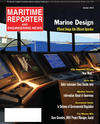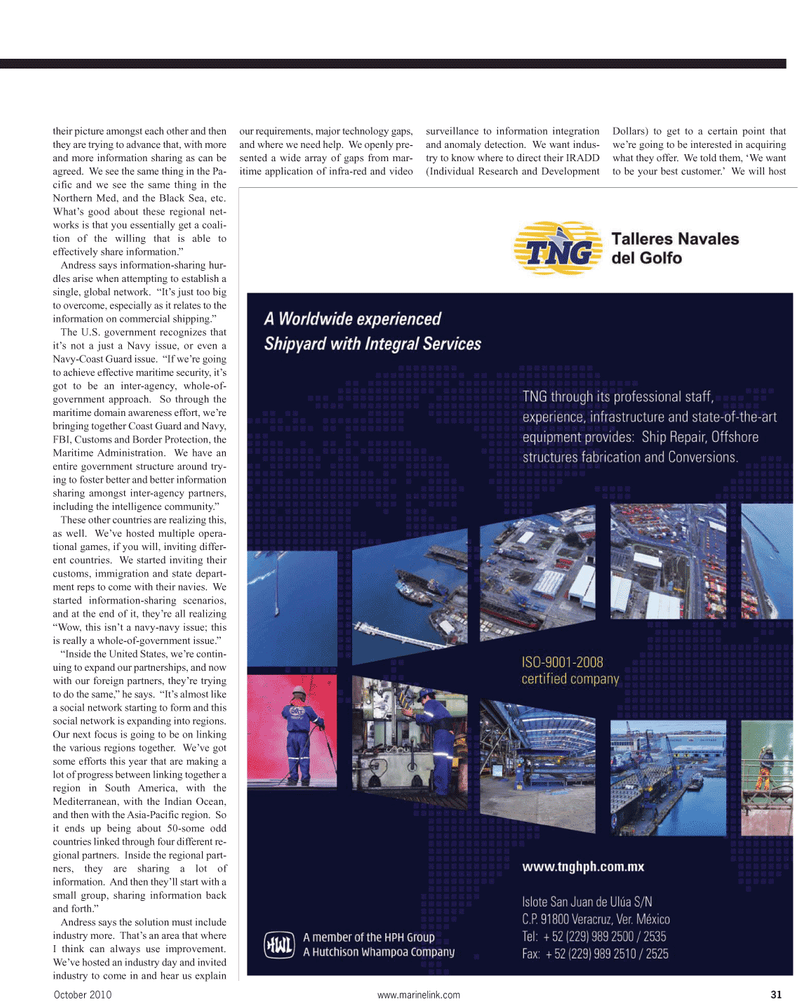
Page 31: of Maritime Reporter Magazine (February 2, 2010)
Read this page in Pdf, Flash or Html5 edition of February 2, 2010 Maritime Reporter Magazine
October 2010 www.marinelink.com 31 their picture amongst each other and then they are trying to advance that, with more and more information sharing as can be agreed. We see the same thing in the Pa- cific and we see the same thing in the
Northern Med, and the Black Sea, etc.
What’s good about these regional net- works is that you essentially get a coali- tion of the willing that is able to effectively share information.”
Andress says information-sharing hur- dles arise when attempting to establish a single, global network. “It’s just too big to overcome, especially as it relates to the information on commercial shipping.”
The U.S. government recognizes that it’s not a just a Navy issue, or even a
Navy-Coast Guard issue. “If we’re going to achieve effective maritime security, it’s got to be an inter-agency, whole-of- government approach. So through the maritime domain awareness effort, we’re bringing together Coast Guard and Navy,
FBI, Customs and Border Protection, the
Maritime Administration. We have an entire government structure around try- ing to foster better and better information sharing amongst inter-agency partners, including the intelligence community.”
These other countries are realizing this, as well. We’ve hosted multiple opera- tional games, if you will, inviting differ- ent countries. We started inviting their customs, immigration and state depart- ment reps to come with their navies. We started information-sharing scenarios, and at the end of it, they’re all realizing “Wow, this isn’t a navy-navy issue; this is really a whole-of-government issue.” “Inside the United States, we’re contin- uing to expand our partnerships, and now with our foreign partners, they’re trying to do the same,” he says. “It’s almost like a social network starting to form and this social network is expanding into regions.
Our next focus is going to be on linking the various regions together. We’ve got some efforts this year that are making a lot of progress between linking together a region in South America, with the
Mediterranean, with the Indian Ocean, and then with the Asia-Pacific region. So it ends up being about 50-some odd countries linked through four different re- gional partners. Inside the regional part- ners, they are sharing a lot of information. And then they’ll start with a small group, sharing information back and forth.”
Andress says the solution must include industry more. That’s an area that where
I think can always use improvement.
We’ve hosted an industry day and invited industry to come in and hear us explain our requirements, major technology gaps, and where we need help. We openly pre- sented a wide array of gaps from mar- itime application of infra-red and video surveillance to information integration and anomaly detection. We want indus- try to know where to direct their IRADD (Individual Research and Development
Dollars) to get to a certain point that we’re going to be interested in acquiring what they offer. We told them, ‘We want to be your best customer.’ We will host

 30
30

 32
32
